Dazzling Roman mosaics discovered near the site of the ancient city of Eloro on Sicily apparently contradict Homer's account of the Trojan war in his epic poem, the Iliad.
"One mosaic depicts the story of the recovery of Hector's body from Achilles, who after killing King Priam's eldest son, dragged his corpse around the walls of Troy, tied to his chariot. Amid a group of Greek and Trojan figures including Achilles and Diomedes, and old King Priam of Troy, Hector's body is shown lying on one of the two plates of a weighing scales, while on the other is Priam's treasure. The scene implies that the ransom for Hector's body was calculated according to his physical weight, rather than his honour, the traditional ancient yardstick for such matters."
Subsection of Roman Times:
Articles about current archaeology and research into the remains of Roman and Byzantine civilizations.
Wednesday, July 30, 2003
Monday, July 28, 2003
Etched Gladiator on glass fragment most exciting find of 2003 at Whitehall Farm Roman Villa & Landscape Project
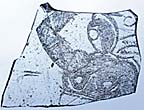 A small piece of fine glass, engraved or etched with the figure of a gladiator is one of the most exciting finds this year at the Whitehall Farm Roman Villa and Landscaping Project. Part of a drinking vessel, it was found in the sealed context of room 3B of the bath house.
A small piece of fine glass, engraved or etched with the figure of a gladiator is one of the most exciting finds this year at the Whitehall Farm Roman Villa and Landscaping Project. Part of a drinking vessel, it was found in the sealed context of room 3B of the bath house.
Researchers said this is only the fifth gladiator vessel found so far in the UK.
Other finds this season include a square game piece, a bone hairpin, and a silver denarius minted by the house of Severus.
3rd Century BC Industrial Iron Ore Kilns Discovered in Lecco, Italy
"According to Marco Tizzoni of Bergamo University 'it is the most ancient proof of iron ore reduction in the [Lombardy] region found thus far. We are looking at what are probably some of the first proto-historic mines in Lombardy'.
The kilns were very simple: small clay structures resting at the feet of the mountain, they were used in conjunction with hand driven vents, which allowed for the creation of iron in a paste form'. "
The kilns were very simple: small clay structures resting at the feet of the mountain, they were used in conjunction with hand driven vents, which allowed for the creation of iron in a paste form'. "
Roman cosmetics' found at ancient dig
Excavators at the site of a major Roman temple in London have found a sealed box containing a white cream still bearing the fingermarks of the person who last used it, nearly 2,000 years ago. Museum conservator Liz Barham who opened the fist-sized cylindrical tin box for the first time on Monday, in front of the world's media, described the smell from the half-full container as "sulphurous" and "cheesy." The substance, which will now be chemically analyzed, could be face cream or even face paintsaid Museum of London curator Francis Grew.
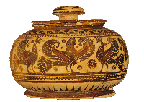 William Smith, D.C.L., LL.D., in an article in A Dictionary of Greek and Roman Antiquities of 1875 explains, "The practice of painting the face was very general among the Greek ladies, and probably came into fashion in consequence of their sedentary mode of life, which robbed their complexions of their natural freshness, and induced them to have recourse to artificial means for restoring the red and white of nature. This at the least is the reason given by some of the ancient writers themselves (Xen. Oecon. 10 c.10; Phintys, ap. Stobaeum, tit. lxxiv.61). The practice, however, was of great antiquity among the Greeks, and was probably first introduced among the Asiatic Ionians from the East, where the custom has prevailed from the earliest times. "
William Smith, D.C.L., LL.D., in an article in A Dictionary of Greek and Roman Antiquities of 1875 explains, "The practice of painting the face was very general among the Greek ladies, and probably came into fashion in consequence of their sedentary mode of life, which robbed their complexions of their natural freshness, and induced them to have recourse to artificial means for restoring the red and white of nature. This at the least is the reason given by some of the ancient writers themselves (Xen. Oecon. 10 c.10; Phintys, ap. Stobaeum, tit. lxxiv.61). The practice, however, was of great antiquity among the Greeks, and was probably first introduced among the Asiatic Ionians from the East, where the custom has prevailed from the earliest times. "
He continues, "In order to produce a fair complexion, cerussa, or white lead was employed. The eye-brows and eye-lids were stained black with a sulphuret of antimony, which is still employed by the Turkish ladies for the same purpose. The eye-brows were likewise stained with a preparation of soot.
Roman ladies even went so far as to paint with blue the veins on the temples, as we may infer from Propertius (ii.14.27) "si caeruleo quaedam sua tempore fuco tinxerit." The ridiculous use of patches (splenia), which were common among the English ladies in the reign of Queen Anne and the first Georges, was not unknown to the Roman ladies (Mart. ii.29.9, x.22; Plin. Ep. vi.2). The more effeminate of the male sex at Rome also employed paint. Cicero speaks (in Pison. 11) of the cerussatae buccae of his enemy, the consul Piso.
See also: Fucus
Cosmetics were also valuable trade items:
I also came across this reference:
"From Homer's day forward, precious oils, perfumes, cosmetic powders, eye shadows, skin glosses and paints, beauty unguents, and even hair dyes seem to have been in near universal use. Export and sale of these items formed an important part of trade around the Mediterranean. During the 8th and 7th centuries BC, overseas markets were dominated by Corinthian, Rhodian and East Greek perfume flasks and cosmetic containers, including aryballoi, alabastra, pyxides and other small specialized shapes. Cosmetic unguents were imported into Greece in containers carved from the Red Sea Tridacna shell."
 William Smith, D.C.L., LL.D., in an article in A Dictionary of Greek and Roman Antiquities of 1875 explains, "The practice of painting the face was very general among the Greek ladies, and probably came into fashion in consequence of their sedentary mode of life, which robbed their complexions of their natural freshness, and induced them to have recourse to artificial means for restoring the red and white of nature. This at the least is the reason given by some of the ancient writers themselves (Xen. Oecon. 10 c.10; Phintys, ap. Stobaeum, tit. lxxiv.61). The practice, however, was of great antiquity among the Greeks, and was probably first introduced among the Asiatic Ionians from the East, where the custom has prevailed from the earliest times. "
William Smith, D.C.L., LL.D., in an article in A Dictionary of Greek and Roman Antiquities of 1875 explains, "The practice of painting the face was very general among the Greek ladies, and probably came into fashion in consequence of their sedentary mode of life, which robbed their complexions of their natural freshness, and induced them to have recourse to artificial means for restoring the red and white of nature. This at the least is the reason given by some of the ancient writers themselves (Xen. Oecon. 10 c.10; Phintys, ap. Stobaeum, tit. lxxiv.61). The practice, however, was of great antiquity among the Greeks, and was probably first introduced among the Asiatic Ionians from the East, where the custom has prevailed from the earliest times. "
He continues, "In order to produce a fair complexion, cerussa, or white lead was employed. The eye-brows and eye-lids were stained black with a sulphuret of antimony, which is still employed by the Turkish ladies for the same purpose. The eye-brows were likewise stained with a preparation of soot.
Roman ladies even went so far as to paint with blue the veins on the temples, as we may infer from Propertius (ii.14.27) "si caeruleo quaedam sua tempore fuco tinxerit." The ridiculous use of patches (splenia), which were common among the English ladies in the reign of Queen Anne and the first Georges, was not unknown to the Roman ladies (Mart. ii.29.9, x.22; Plin. Ep. vi.2). The more effeminate of the male sex at Rome also employed paint. Cicero speaks (in Pison. 11) of the cerussatae buccae of his enemy, the consul Piso.
See also: Fucus
Cosmetics were also valuable trade items:
I also came across this reference:
"From Homer's day forward, precious oils, perfumes, cosmetic powders, eye shadows, skin glosses and paints, beauty unguents, and even hair dyes seem to have been in near universal use. Export and sale of these items formed an important part of trade around the Mediterranean. During the 8th and 7th centuries BC, overseas markets were dominated by Corinthian, Rhodian and East Greek perfume flasks and cosmetic containers, including aryballoi, alabastra, pyxides and other small specialized shapes. Cosmetic unguents were imported into Greece in containers carved from the Red Sea Tridacna shell."
Friday, July 18, 2003
Conservation Continues at Sagalassos
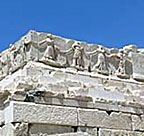 A beautiful frieze of dancing girls that adorns the NW Heroon, an honorific monument, dedicated to a prominent figure of the city and built in Augustan times (25 B.C.-A.D. 14), has been freed of its winter protection. A new study of the naiskos (platform) blocks indicated that almost nothing was missing of the latter. Also, it turned out that it was not a distylos in antis (two columns set between projecting side walls), but a tetrastyle prostylos (four columns set in front of the cella) shrine built in the Corinthian order.
A beautiful frieze of dancing girls that adorns the NW Heroon, an honorific monument, dedicated to a prominent figure of the city and built in Augustan times (25 B.C.-A.D. 14), has been freed of its winter protection. A new study of the naiskos (platform) blocks indicated that almost nothing was missing of the latter. Also, it turned out that it was not a distylos in antis (two columns set between projecting side walls), but a tetrastyle prostylos (four columns set in front of the cella) shrine built in the Corinthian order.
Work also continues on the Antonine Nymphaeum, a monumental fountain located on the north side of the Upper Agora and dated to the reign of Marcus Aurelius (A.D. 161-180).
Wednesday, July 16, 2003
Roman brooch discovery pushes ancient frontiers farther north in Scotland
 A Roman brooch, dated to between 50BC and 50AD, has been discovered by amateur archaeologists in Shetland. The ancient pin could have belonged to an islander returning to the area around Norwick on Shetland after serving in the Roman army.
A Roman brooch, dated to between 50BC and 50AD, has been discovered by amateur archaeologists in Shetland. The ancient pin could have belonged to an islander returning to the area around Norwick on Shetland after serving in the Roman army.
Experts at the British Museum believe the one found on Shetland, from the late Iron age/early Roman period, could have been made in Germany.
Dr Alan Leslie, director of the Glasgow University archaeological research division, said: "The brooch gives an indication of the extensive trading networks at the time.
"It could have been used as something to barter with and is certainly a very special find. There was substantial seaborne mercantile activity but it could have got there via other agencies. The Roman army was established in different areas and shifted about a lot. There were legionaries who were Roman citizens and auxiliary units from allied or conquered countries. Someone could join the army, serve their 25 years, and then move back to their locality."
Weekend detectors find variety of ancient brooches
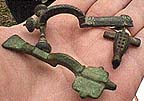 Digs sponsored by The Weekend Wanderers Detecting Club, founded by Peter Welch in 1997, have yielded an impressive variety of early Roman and Saxon brooches. Weekly digs take place in and around Hertfordshire, Buckinghamshire, Berkshire, Hampshire, Surrey, and Oxfordshire in the UK.
Digs sponsored by The Weekend Wanderers Detecting Club, founded by Peter Welch in 1997, have yielded an impressive variety of early Roman and Saxon brooches. Weekly digs take place in and around Hertfordshire, Buckinghamshire, Berkshire, Hampshire, Surrey, and Oxfordshire in the UK.
Fish fossils reveal Roman trade routes: Genetics shows ancient Anatolians imported Egyptian catfish
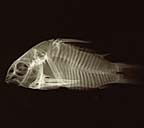 Fish fossils found in an excavation of Sagalassos, 110 kilometres inland from Turkey's southern Mediterranean coast, have added to growing evidence that Sagalassos had connections with far-flung regions of the Roman Empire. 1400-year old remains of an Egyptian catfish dinner were identified by genetic analysis.
Fish fossils found in an excavation of Sagalassos, 110 kilometres inland from Turkey's southern Mediterranean coast, have added to growing evidence that Sagalassos had connections with far-flung regions of the Roman Empire. 1400-year old remains of an Egyptian catfish dinner were identified by genetic analysis.
"The catfish was probably a delicacy for aristocrats," says the director of the dig Marc Waelkens from the Catholic University of Leuven, Belgium. Romans may also have imported these and other exotic fish to stock their decorative pools. Waelkens and his colleagues found Nile perch (Lates niloticus) and African tilapia (Tilapia zillii) at the site too, they report in this month's Journal of Archaeological Science .
Ancient Roman Fonts
 Michael Scarpitti has designed some unique fonts "based on historical sources from different eras of the Roman Empire and are extraordinarily accurate to the details of the different lettering styles which they represent. These are not modernized abstractions of popular styles like Rustica and Roman Uncial, but grittier, more interesting designs derived directly from ancient manuscripts and inscriptions. This is Roman lettering as it was actually done, not a contemporary designer's reinterpretation."
Michael Scarpitti has designed some unique fonts "based on historical sources from different eras of the Roman Empire and are extraordinarily accurate to the details of the different lettering styles which they represent. These are not modernized abstractions of popular styles like Rustica and Roman Uncial, but grittier, more interesting designs derived directly from ancient manuscripts and inscriptions. This is Roman lettering as it was actually done, not a contemporary designer's reinterpretation."
His entire set of fonts is available for $49 and he provides Falconis as a free download.
Thursday, July 10, 2003
New Research Reveals Petillius Cerialis Rather Than Agricola founder of Roman Scotland
The traditional view, that the Roman frontier in Scotland was established in the 80s through the campaigns of the governor Agricola has been overturned by findings at the Roman Gask project excavations at Coldoch. The theory was based largely on the writings of Tacitus, Agricola's son-in-law. According to Birgitta Hoffmann, deputy director of the project, the new evidence suggests the founder was more likely Petillius Cerialis, general and diplomat, and governor in 71-73/4.
Pollen evidence from settlements in the area shows no agricultural decline from the 70s - as would be expected if occupation had been achieved through conquest, as many native farmers would have been killed. Instead, it shows the intensification of grazing, with pastures supporting bigger herds.
Evidence from the latest season's work at Coldoch, two miles from the Roman fort of Doune, suggests the natives may have started to grow wheat - a crop not generally grown in Iron Age Scotland - to trade to the Roman army and its camp followers, who may have numbered as many as 20,000. Fragments of 1st century Roman glass at the settlement proves there was contact between incomers and natives.
Pollen evidence from settlements in the area shows no agricultural decline from the 70s - as would be expected if occupation had been achieved through conquest, as many native farmers would have been killed. Instead, it shows the intensification of grazing, with pastures supporting bigger herds.
Evidence from the latest season's work at Coldoch, two miles from the Roman fort of Doune, suggests the natives may have started to grow wheat - a crop not generally grown in Iron Age Scotland - to trade to the Roman army and its camp followers, who may have numbered as many as 20,000. Fragments of 1st century Roman glass at the settlement proves there was contact between incomers and natives.
Ancient canats (water canals) restored for use in Syria
A village, located approximately 70 kilometers southeast of Aleppo near the town of Khanasser, is the first in Syria to have its qanats (water canals), which date from Byzantine times, reactivated. This program, in partnership with the International Center for Research in Dry Areas (ICARDA) and the directorate of the National Museum of Aleppo, gives the locals of Shalala Saghira the chance to use this ancient yet clean and efficient way of getting their water.
During Roman times, these canals connected cities such as Duro Europos, Bosra and Palmyra. The paths of the qanats (basically large tunnels) are so big that one could drive a car through them. The Romans were probably the biggest builders of qanats, though other civilizations also contributed their irrigation techniques to the region. Qanats rely on gravity to carry water and are considered environmentally sound because they do not deplete groundwater resources.
There are an estimated 2,000 qanats in Syria, of which 91 have been identified at 41 sites in the country, with another 30 still flowing.
During Roman times, these canals connected cities such as Duro Europos, Bosra and Palmyra. The paths of the qanats (basically large tunnels) are so big that one could drive a car through them. The Romans were probably the biggest builders of qanats, though other civilizations also contributed their irrigation techniques to the region. Qanats rely on gravity to carry water and are considered environmentally sound because they do not deplete groundwater resources.
There are an estimated 2,000 qanats in Syria, of which 91 have been identified at 41 sites in the country, with another 30 still flowing.
Subscribe to:
Comments (Atom)